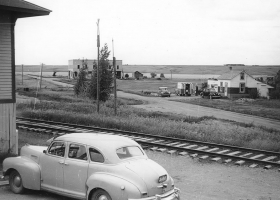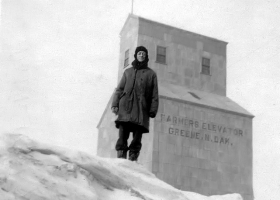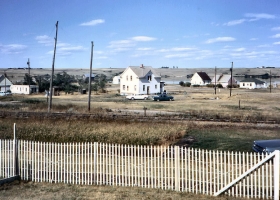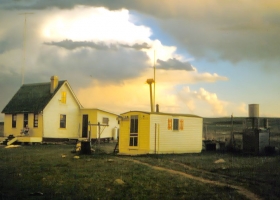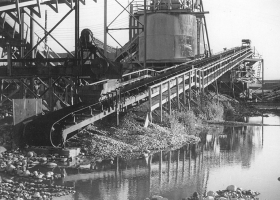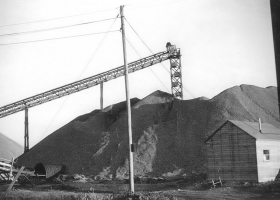SOO Memories From Greene, North Dakota
by Tom Gloger
 Someday the Internet is going to contain all there is to know about every possible subject. This is my contribution: fond recollections of relatives, railroads, and the place known as Greene, North Dakota.
Someday the Internet is going to contain all there is to know about every possible subject. This is my contribution: fond recollections of relatives, railroads, and the place known as Greene, North Dakota.
Greene is located in Renville County in the northwest quarter of North Dakota near where State Route 28 crosses the Souris [Mouse] River. On a railroad map, it is east of Kenmare on former Soo Line tracks, a line now operated by the Northern Plains Railroad as their Bisbee Subdivision.
When I was there, the railroad had only one spur track at Greene. It began south of town, ran past an old stock pen, crossed the gravel road and ran behind the depot to the grain elevators and beyond. As of 2007 satellite imaging seems to indicate the old spur is now a double-ended siding.
At one time Greene was in the running for being the county seat, but lost out to Mohall. In the 1950s, I was told its population was about twelve, depending on how many kids the current grain elevator operator had.
My great-uncle Gerard Bromley Brown, a railroad man, was station agent and telegrapher for the Soo Line at Greene. His wife, Juno, kept house and occasionally cooked for the section gang when they were working in that area.
Bromley was also a HAM radio operator. Some other HAM radio operators in those days used microphones to communicate, but Bromley only used Morse code. Any other signals he disdainfully dismissed as “Monkey Talk.” He had a metalworking lathe in the freight room (later moved to the house) and a three-wheeled track car with a gasoline engine.
Juno could understand the telegraph sounder too. She once told me about how one day while she was sweeping the floor of the depot she heard over the telegraph that a runaway boxcar, set in motion by the wind, was headed in her direction. Remembering that the lineman had gone past the depot just a little while before, she ran out to see if he was still in sight. He was up a telegraph pole and his speeder was sitting on the track.
She ran barefoot up the track, shouting a warning to him. He got down the pole as fast as he could, and together they got his speeder off the track just in time. The boxcar shot past with a man hanging on for dear life. He had jumped aboard to try to set the handbrakes, but the rocking motion of the car became too great before he had a chance. The car left the rails south of Greene and overturned, and the man riding the car lost his life.
My first visit to Greene was in 1951. I’m told Bromley and Juno were living in the depot at that time. I was three years old, so my recollections are few and indistinct.
I recall being lifted up into the cupola of a caboose, and being told the train crew called it “the crow’s nest.” I looked around, but saw no crows. Then they told me it had something to do with ships. Grownups can be so confusing at times.
I also vaguely recall seeing a house being moved across the track, and confusing it with a house that was to be moved across our street back home that same summer.
The most memorable visit was when my mother, my older sister, brother and I (the youngest by four years) spent half a summer there in 1957.
We went to North Dakota on a Great Northern Railway train named The Western Star, which left Chicago at 10:30 PM. I got the impression there some kind of trouble farther up the line for it seemed we never went very fast and ofttimes were stopped for no apparent reason. At one point I’m sure we were even going backwards!
There was one bright spot come the next morning, we were run through the yards at St. Paul where they washed the outside of the train. The man doing the windows with a long-handled mop saw our forlorn faces at the coach window and added an extra little scrub right where our faces were. Needless to say he then saw our grinning faces at all the rest of the windows of the car, and probably would have seen them in the next car too, if mother hadn’t stopped us. Thanks Mister, wherever you are.
After that, there wasn’t much to do except think up excuses to go to the water cooler to get an icy cold sip of water from a flimsy conical white paper cup. Eventually, I think, the cooler ran out of cups and no one got any water after that.
By the way, if you’ve never sat in a passenger train as it passes a freight train headed the other direction, let me tell you the combined speed of the two trains makes the effect quite breathtaking.
You’re sitting there, placidly watching the distant scenery slowly rolling past, when suddenly the window darkens and there is a roar of passing locomotives. In a split second, it is replaced by freight cars roaring past just outside the window at a rate approaching four cars per second. Red cars, black cars, tall cars, short cars. You no sooner see one than it’s replaced by another, each one lending its own kind of acoustics to the roar.
Then, in the blink of an eye, the last car shoots by and there’s the scenery again, slowly rolling past as if nothing had happened.
But that happened only a few times, and never when we wished it would. Most of the time it was just hours of endless flat lands. To this day, that trip is the standard by which I measure boredom.
We arrived at Minot, North Dakota, late in the day. I remember seeing a statue of a mountain goat (The Great Northern’s trademark) at the station. Our cousin Bonnie picked us up and drove us to Greene where we went straight to bed.

North end of the Soo Line Depot at Greene, North Dakota, 1951
I remember several things from that trip, but not their chronological order. Here are a few of them:
A few things had changed since our previous visit. Bromley and Juno had a house of their own now, on a rise overlooking the tracks, the depot and the town. The kitchen on the side of the house had a hand pump that took water from a cistern. I don’t know how the cistern was filled normally, but there was a drought the year we were there, or something like it. We often saw rain in the distance, but we got rain only two or three times and not very much.
Whenever the cistern ran low, the adults sent us kids down toward the river where there was a hand pump to get water. We took a couple cream cans in a coaster wagon and a couple buckets we’d carry by hand. My brother would pump until the water came, then we’d fill the containers and lug them home.
One time my brother told me if I wanted to see something neat I should look down into the top of the pump while he pumped it really hard. I’d never noticed before how fast water could come shooting out the top of the pump, but I did that day. He’s still like that sometimes, but I kinda like him anyway.

We weren’t the only guests in Greene that summer. There was another boy; I think his name was Billy that often played with us, especially with my brother. He was a bit wilder and rowdier than the three of us but then most other kids were. I think it was he that talked my brother into climbing to the roof of some boxcars parked on the siding and jumping from car to car like an old-time brakeman. It wasn’t a difficult jump, and they had no trouble, but I wonder what the grownups would have said about it had they known. Billy thought up a lot of things that got us in trouble with the grownups
That in itself wouldn’t have been so bad, but whenever there was a dispute among us, even when it seemed clear to us that Billy was at fault, the grownups all tended to side with Billy. More about that later.
I, being the youngest by four years, didn’t always get in on whatever the older kids were up to. I recall one time I was tagging along and they managed to shake me by taking a turn around the cattle pen by the siding. You can see part of the pen in the picture with the double rainbow, just behind the flatcar. I got half way around before I noticed I was into a patch of nettles that grew along the fence. I tried climbing the fence to get away from them, but cattle pens being what they are, these nettles were well fertilized and very tall. By the time I got out of the nettles, the older kids were long gone and I was itchy.
Billy and my brother talked Uncle Bromley into letting them play with his three-wheel track car, as long as they kept it on the siding and didn’t start up the motor. They tried sail power, but without much success. There wasn’t enough track to get up any speed, and I think the mast kept coming loose. Building stuff like that is harder than it seems to those who have never tried it. They wound up pushing it back and forth, until the day my brother burst into the house and announced that Billy was being violently sick to his stomach. It seems Billy had been lying face down on the car, trying to count crossties as my brother pushed – a sure recipe for motion sickness. Their fascination with that track car waned after that, and I felt a certain satisfaction that Billy had finally suffered the consequences of his actions in a way that no grownup could do anything about.

One day Uncle Bromley persuaded a man from the section gang to give my sister, my brother, and I a ride on his motor car. It was strictly against the rules, but he obliged. I guess there were no trains scheduled that day.
We headed east across the river and started up through the cuts on the long grade toward Grano. At no time did our speed exceed twenty-five miles an hour. After the novelty of riding on one of these “putt-putt” cars wore off, and I began to look around, I noticed the local birds liked to land on the tracks between the rails and wait for our approach, flying off at the last second. I suppose they were trying to impress their lady friends with how brave they were.
When we got within sight of Grano’s Elevator (or was it a municipal water tower?) the section hand stopped and took us back to Greene before we were spotted.

If you look closely at the pictures of the depot near the top of the page, you can see a small signal device hanging from the eaves of the depot just outside the bay window. It’s maybe a foot long and painted red, the ends are rounded and have holes in them. I asked Uncle Bromley what it was for, and he said it was an order board. If he set it crossways, he said, the train would stop and not move until he cleared it. In fact, he said, the engineer wouldn’t move the train even if the President of the United States got down on his knees and begged him to move it. I tried to imagine President Eisenhower, as I’d seen him in My Weekly Reader, down on his knees in the gravel, his bald head gleaming and the engineer standing on his locomotive with his arms folded, shaking his head. It was quite a stretch, but what he said was true.
1957 was the summer the spur leading to Shiely’s rock quarry was removed. Shiely’s quarry had been used to supply material used in the construction of Garrison Dam, which was built between 1947 and 1953. The spur was south of Greene, about where the main line curved off to the left to cross the Souris River on a wooden trestle. The spur continued straight on to the quarry, where rock crushers broke rocks from the glacial deposits into a suitable size. My uncle said he wrote the waybills (a kind of train ticket, but for freight) for every single load that came out of there.
The work crew assigned to remove the siding parked their equipment on the spur near the depot at night and then took what they needed to the work site each morning.
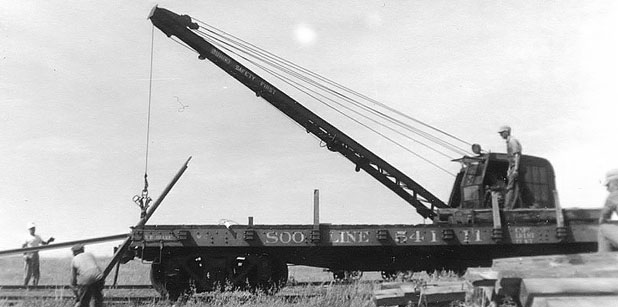
Work crew salvaging the rail from Shiely's Spur
Several of us were down there one afternoon, watching the action, when we heard voices raised in anger. A flat car had to be moved a few feet before work could continue and even though the self-propelled Burro crane was capable of it, using it to move a freight car was using it as a locomotive and union rules required the presence of both an engineer and a fireman on locomotives. The Union men won out, a fireman was sent for and work stopped, to remain at a standstill until he arrived. We spectators trooped back up the track to the house.

I recall one evening we walked down the track to flag down the train and get ride into town. It was getting dark when the train arrived, and the step up to the combination coach was higher than I could manage, so I was hauled aboard by the arms.
Once in the coach, I looked around. There were no other passengers and the conductor had a desk in the passenger compartment near the baggage section. He lit a kerosene lamp, placed it on the desk and then turned away to take care of other business.
I watched, fascinated, as the flame grew taller and thinner until it was starting to come out the top of the chimney. The conductor, who had been distracted by our arrival, finally caught it and turned it down before it got much higher.

One day we went to the nearby city of Bowbells, where my cousin Bonnie owned and operated a hotel. The town was celebrating Pioneer Days, complete with speeches and a carnival with games and rides.
I tried a few games with no luck at all, and finally settled on one booth where for 10¢ the man would spin the wheel and you would win your choice of anything off the shelf corresponding to the number the wheel landed on.
At the time, the name Pioneer Days seemed to me to be kind of an exaggeration. Years later I did the math and realized some of the older people there may very well have been the first settlers in that area
On one of our trips to Bowbells, we all got presents. Mine was a small silver lantern with room in the base for two C cells, and a switch made of fiberboard and stamped metal parts to light up any one of three small bulbs inside. It came without batteries and bulbs, and the store didn’t have colored bulbs, which I thought demonstrated a decided lack of foresight on their part. Mother wrote to dad back home, and he sent us a “care” package that included three bulbs, two of which he had hand colored red and green. My Dad could do anything. Even with the new bulbs in it the lantern was very difficult to operate as the contacts were intermittent at best. It would work only if you kept your finger on the switch, gently twisting it in just the right way.
I remember pleading with Uncle Bromley to allow me to carry it when the evening train stopped. When I could not convince him, I pled my case before the other grownups in the house. Bromley finally allowed me to carry it, but made sure I understood that I was not to turn it on or swing it at all, or he’d wring my neck. Now that I’m older, and know how lantern signals were used to pass instructions to the engineer at the throttle, I understand what an awful risk he took.
I still have that little lantern. I got it out recently, and carefully adjusted the contacts and put in fresh batteries. It still lights up, if you keep your finger on the switch, and gently twist it in just the right way.
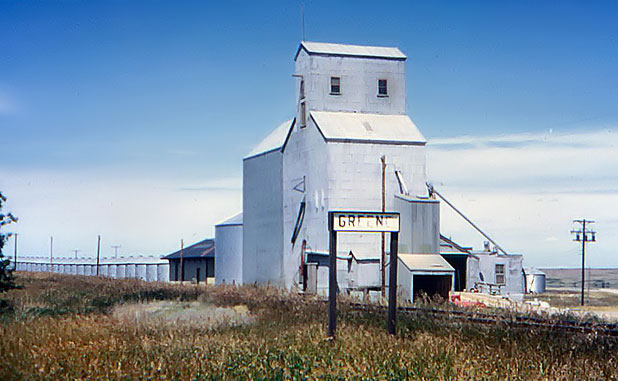
Elevator in Greene, North Dakota
Some of the other things I remember were:
Putting together jigsaw puzzles. They were kept in the attic, and it was so hot up there we only stayed long enough to put back the puzzle we’d just finished and pick out another. The one I remember best showed an old steam train, smoke and sparks erupting from its stack about to cross the path of a runaway team and wagon.
Going down to Ole’s (the general store) to get yet another bottle of Squirt.
Playing the game of Careers. I generally choose a goal weighted toward great happiness, and generally lost.
Watching some men on horseback drive a small herd of cattle along the road near the house. We weren’t allowed off the porch until they were past.
Visiting a farm on the other side of the river. I watched the farmer milk a cow, then pour the milk into a separator to get the cream. The skim milk was given to the cow’s newly weaned calf to drink. It seemed to me like the calf got the short end of the deal. There were two kids about my age on that farm, but I was such a know-it-all brat that I think they eventually got disgusted with me and made their selves scarce.

Greene, North Dakota
When the time came to return to Chicago, we got up early on a Monday morning in order to drive from Greene to Minot in time for the Western Star, which was scheduled to leave at 6:15 AM. We waited quite a while for it to come. I recall seeing a baggage wagon on the platform with a large block of ice on it.
My main memory of the return trip is again from St. Paul. The eastbound Western Star arrived at St. Paul around 3:30 PM. Once there, we found its schedule called for a seven-hour stopover at St. Paul, so mother bought us each a magazine in anticipation of a long boring wait. It must have been around 3:57 when she learned our tickets were good on the Burlington’s Twin Zephyr, which was leaving for Chicago in three minutes!
We grabbed our luggage and ran across the waiting room. It was quite a strain for me to carry my suitcase, being barely nine years old. I said as much to Mother, and while I don’t recall her exact answer, she made it clear there would be no stopping to rest until we were on the train.
We caught the Zephyr, then sat down to catch our breath. As we recovered, we began to take stock of our surroundings. This was no Western Star! The cars were gleaming stainless steel and there were dome cars. It ran faster too. The Western Star would have taken eight hours and forty minutes to go from St. Paul to Chicago. The Zephyr made the same trip in under seven hours.
Mother let us kids explore this train as long as we all kept together. Her attitude may have changed over the summer because we’d all grown up a bit.
Seats in the dome cars were open to all riders so we sat there a while, watching the Mississippi scenery slide past. The only clue to the actual speed of the train was when we looked across the tops of the rocking cars ahead to where the engine’s exhaust was swept back by the wind.
Next, we headed for the observation car in the rear of the train. To pass from car to car, one first opened the heavy door at the end of the passenger area, letting in the roar and clatter from the outside. Then one jumped over the footplates between cars. It was easier than it looked, for they were in constant motion, shifting unpredictably with the movement of the train and the roaring was terrific. One then muscled open the door to the next car and stepped inside, letting the door close itself. We would then walk the length of the car and repeat the process. Sometimes the cars were the same as ours, and sometimes they were different with a narrow aisle right along the windows on one side or the other.
We finally reached the observation car, which wasn’t an open-platform car like we had on our toy electric trains, but was streamlined with long windows letting in the light, furnished almost like a living room. We took two steps into the car and were stopped by the porter who informed us the observation car was only open to those who had bought a special ticket. Being kids, we probably tried to point out how unfair that was. After all, we’d left the station and could no longer purchase such a ticket. I think we were on the point of being ejected from the car when one of the men sitting there spoke up and persuaded the porter it would be OK to let us stay for a while, as long as we were quiet and well behaved. Thank you, Mister!
Seen from the end of the train, the scenery now receded into the distance. The two pairs of shiny rails seemed almost unmoving, except once in a while when a third pair of rails would emerge from one track, swoop over to the other, and swiftly blend in.
I noticed the observation car alternated between riding smoothly and gently rocking from side to side, a trait I hadn’t noticed in any other car. After a few minutes we left, but not without swiping a red plastic swizzle stick or two from a stainless steel holder on the wall near the door, to “get back” at the porter. Kids have a very flexible sense of justice.
We reached Chicago on time, and mother called dad from the station, explaining the early arrival. Dad came and got us in the car and we drove home. It was good to be back.

The following summer, Mother announced casually that Billy, the boy who had caused us so much trouble, had died a few days before. He had had leukemia.
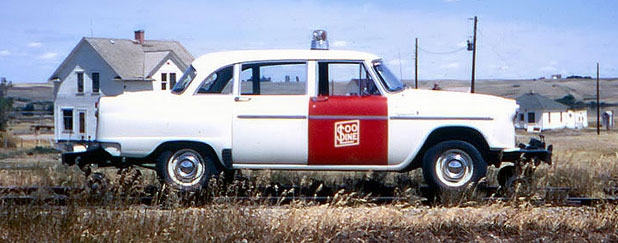
A Checker Marathon model automobile in Soo Line paint, fitted with retractable flanged wheels
In late July, 1967, while on vacation with a friend, I stopped in to visit for a few hours. My great-uncle was retired, and had moved his lathe into the house. The old depot building had been sold to the grain elevator operators who had it moved down beside the elevator to use as a storage building.
Looking back, I understand now what had happened: For over 100 years in the United States, railroads were operated by a system known as “Timetable and Rulebook.”
The timetable specified the times and locations at which trains traveling in opposite directions were normally to meet and pass. The rulebook, which operating employees were required to memorize, contained specific instructions to follow to interpret the timetable and keep the trains safe. Station agents reported passing trains to the train dispatcher, so he could follow their progress. When properly executed, this system kept the trains from running into each other.
If the safe and efficient operation of a railroad required a departure from the timetable and rulebook, the dispatcher would send “train orders” by Morse code to station operators, who would write them out and pass them up to the engineer and conductor of the effected trains as they went by. In some cases, an order might be of such critical importance that the train would be stopped so the engineer and conductor could sign for it, thus the need for the order board I mentioned earlier.
But by 1967, trains received their instructions directly by radio and the order board and the telegraph, the depot and my uncle, were no longer needed to keep the trains safe and on schedule.
Tom Gloger’s Website: http://www.thomasgloger.com/
Category: Blog



